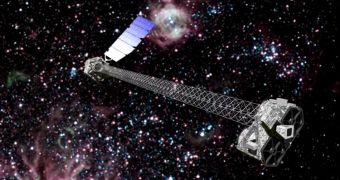When NASA launches its Nuclear Spectroscopic Telescope Array (NuSTAR) mission, this June, the international scientific community will gain access to the first space-based X-ray observatory that can be focused. Experts expect to get images at least 10 times clearer than possible with current spacecraft.
Managed by scientists at the NASA Jet Propulsion Laboratory (JPL), in Pasadena, California, the telescope is being built by main contractor ATK Space Systems and Orbital Sciences Corporation.
Though an exact launch date has not yet been revealed, it is known that NuSTAR will be ferried to orbit aboard a Pegasus XL delivery system, which will launch from underneath the L-1011 Stargazer aircraft. The latter will be deployed from an airbase on Kwajalein Atoll, in the Pacific Ocean.
The mission is scheduled to last for about 2 years, during which the telescope will conduct nuclear spectroscopy investigations of high-energy X-ray sources in the 5-to-80 kiloelectronvolt (keV) energy range. The satellite will orbit the planet at an altitude of around 550 kilometers (about 342 miles).
Some of its preferred targets will be supermassive and stellar-size black holes, merging neutron stars, exploding stars, and other similar events. The solar atmosphere will also be investigated in detail.
The most ambitious goal of the mission is to compile a census of all black holes in the Universe. Due to its technical specifications, it will be able to discover such objects even if they are hidden in galaxies obscured by thick clouds of cosmic dust and hydrogen gas.
Additionally, the spacecraft will need to determine how fast black holes are spinning. At this point, astrophysicists do not have any clear values to associate with this phenomenon. Models suggest that matter falling through the event horizon constantly accelerates the speed at which these objects spin.
“When two black holes merge, all of that rotation will end up in a single object, making it spin very fast. NuSTAR is going to measure how fast black holes are spinning, which gives us information about how the black holes formed and what role they play in the formation of galaxies,” a press release from NASA explains.
Astrophysicists say that the instrument may also reveal structures, objects or phenomena that weren't even hinted at before. Scientists will need to keep their eyes peeled when investigating the datasets NuSTAR will send back to Earth.
Missions such as this have the potential to change the way we look at the Universe and its components.

 14 DAY TRIAL //
14 DAY TRIAL // 